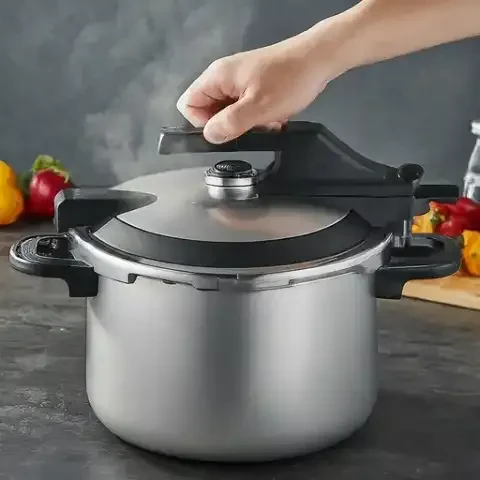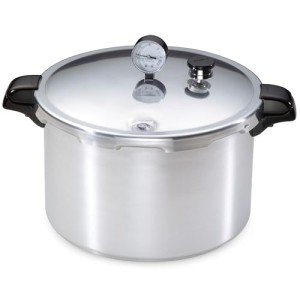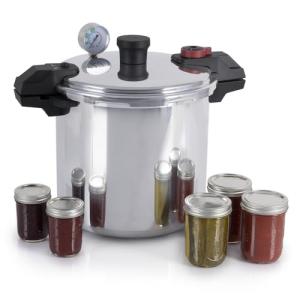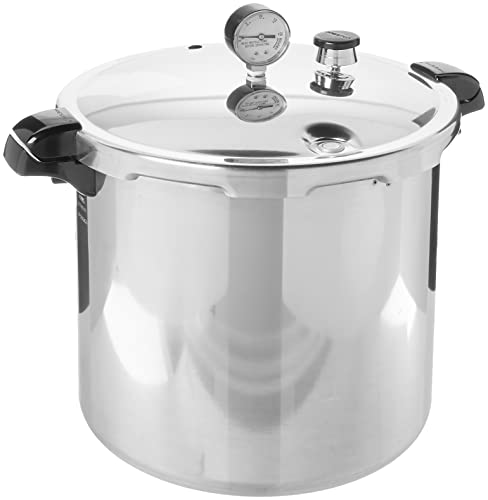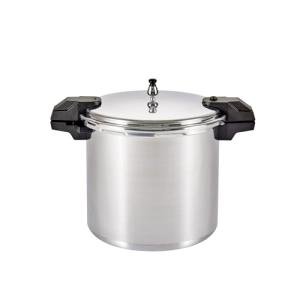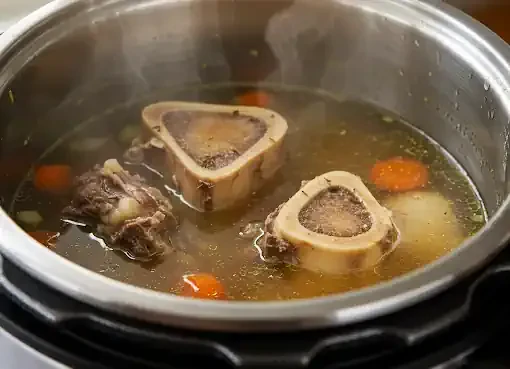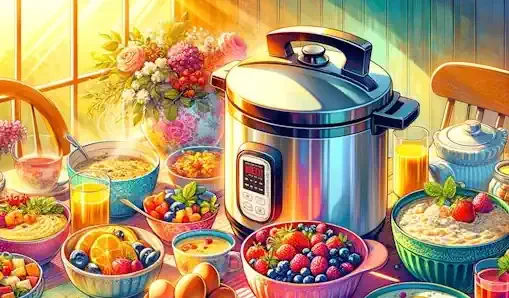Introduction
Pressure cookers have long been hailed as indispensable kitchen tools, revolutionizing the way we cook by drastically reducing cooking times while intensifying flavors. In recent years, with the rise of busy lifestyles and a growing emphasis on efficiency in the kitchen, the popularity of pressure cookers has soared. However, with the abundance of options flooding the market, from traditional stovetop models to sleek electric variants, choosing the right pressure cooker can be a daunting task. This article aims to demystify the process, guiding you through the maze of choices to find the best pressure cooker that suits your needs.
Pressure Cookers Benefits
At its core, a pressure cooker is a sealed pot that cooks food quickly by using steam pressure. By trapping steam inside the pot, pressure cookers raise the boiling point of water, allowing food to cook faster than conventional methods. This not only reduces cooking times by up to 70% but also helps retain nutrients and flavors that might otherwise be lost through prolonged cooking.
Importance Of Selecting The Right Pressure Cooker
Investing in the right pressure cooker can significantly impact your cooking experience. A well-chosen pressure cooker not only saves time and energy but also opens up a world of culinary possibilities, from tenderizing tough cuts of meat in minutes to whipping up flavorful soups and stews with minimal effort. Conversely, a subpar pressure cooker can lead to frustration, undercooked meals, or even safety hazards. Therefore, it's crucial to consider various factors when making your selection.
What Makes A Pressure Cooker The Best Choice
So, what sets the best pressure cookers apart from the rest? While the answer may vary depending on individual preferences and needs, several key criteria distinguish top-tier pressure cookers. These include performance, safety features, ease of use, durability, and versatility. Throughout this article, we'll delve into each of these aspects, providing you with the knowledge and insights needed to make an informed decision. Whether you're a seasoned chef or a novice home cook, our goal is to help you find the perfect pressure cooker that will elevate your culinary creations to new heights.
Understanding Pressure Cookers
Explanation Of How Pressure Cookers Work
To truly appreciate the benefits of pressure cookers, it's essential to understand the science behind their operation. At its core, pressure cooking harnesses the power of steam to cook food quickly and efficiently. When liquid (typically water or broth) is added to the pressure cooker and heated, it begins to boil and evaporate, producing steam. As the steam builds up inside the sealed pot, it raises the pressure, thereby increasing the boiling point of the liquid. This elevated pressure and temperature accelerate the cooking process, allowing food to cook in a fraction of the time required by conventional methods.
Unlike traditional cooking methods that rely on a constant temperature, pressure cookers maintain a high level of pressure throughout the cooking process. This not only speeds up cooking times but also helps break down tough fibers in meats and root vegetables, resulting in tender and succulent dishes.
Different Types Of Pressure Cookers Available
Pressure cookers come in various shapes, sizes, and designs, each offering unique features and benefits. The two primary types of pressure cookers are stovetop and electric models.
Stovetop Pressure Cookers: These classic pressure cookers are designed to be used on traditional stovetops, whether gas, electric, or induction. They typically consist of a durable metal pot with a locking lid equipped with a pressure release valve. Stovetop pressure cookers offer excellent heat distribution and control, allowing for precise cooking. They're often favored by professional chefs and cooking enthusiasts for their reliability and versatility.
Electric Pressure Cookers: On the other hand, electric pressure cookers, also known as multi-cookers or instant pots, have surged in popularity in recent years. These all-in-one appliances combine the functions of a pressure cooker, slow cooker, rice cooker, steamer, and more, all in a single countertop device. Electric pressure cookers feature programmable settings, digital displays, and built-in safety mechanisms, making them user-friendly and convenient for everyday cooking.
Pros And Cons Of Each Type
Both stovetop and electric pressure cookers have their advantages and limitations, and the choice between them ultimately depends on individual preferences and cooking needs.
Stovetop Pressure Cookers
Pros:
Superior heat control and distribution.
Durable construction, often made of stainless steel or aluminum.
No reliance on electricity, suitable for use in camping or off-grid situations.
Versatility for searing and sautéing directly on the stovetop.
Cons:
Requires monitoring of heat levels and pressure adjustments.
Longer preheating time compared to electric models.
Limited programming and automation features.
Electric Pressure Cookers
Pros:
Convenient and easy to use, with programmable settings and one-touch operation.
Versatility with multiple cooking functions in one appliance.
Built-in safety features, including automatic pressure release and lid locking.
Set-and-forget convenience, allowing for unattended cooking.
Cons:
Slower heating and pressure build-up compared to stovetop models.
Limited capacity for searing and browning.
Reliance on electricity, which may not be suitable for certain situations.
Understanding the differences between stovetop and electric pressure cookers is crucial for making an informed decision based on your cooking preferences, kitchen setup, and lifestyle. Whether you opt for the traditional charm of a stovetop pressure cooker or the modern convenience of an electric multi-cooker, both types offer the transformative power of pressure cooking to enhance your culinary adventures.
Key Features to Consider
Selecting the best pressure cooker requires careful consideration of various features and specifications to ensure it meets your cooking needs and preferences. Below are key factors to evaluate when choosing a pressure cooker:
Capacity: Determining The Right Size For Your Needs
One of the first considerations when selecting a pressure cooker is its capacity, which refers to the volume of food it can accommodate. Pressure cookers come in a range of sizes, typically measured in quarts or liters. Common sizes include 4, 6, 8, and 10-quart models.
To determine the appropriate capacity for your needs, consider the following:
Family size: Choose a pressure cooker large enough to comfortably feed your household. For smaller families or individuals, a 4 or 6-quart model may suffice, while larger families may require an 8 or 10-quart cooker.
Cooking habits: Take into account the types of meals you frequently prepare and the quantities you typically cook. If you enjoy batch cooking or entertaining guests, a larger capacity pressure cooker may be beneficial.
Storage space: Consider the available storage space in your kitchen. While larger capacity cookers offer versatility, they also require more storage space when not in use.
It's essential to strike a balance between capacity and practicality to ensure your pressure cooker fits seamlessly into your cooking routine.
Material: Comparing Stainless Steel, Aluminum, And Non-Stick Options
Pressure cookers are commonly constructed from three primary materials: stainless steel, aluminum, and non-stick coatings. Each material has its advantages and considerations:
Stainless Steel: Stainless steel pressure cookers are durable, resistant to corrosion, and non-reactive, making them suitable for cooking a wide range of ingredients. They offer excellent heat distribution and are easy to clean. However, stainless steel cookers tend to be heavier and more expensive than aluminum models.
Aluminum: Aluminum pressure cookers are lightweight, affordable, and conduct heat efficiently, resulting in faster cooking times. However, aluminum is prone to reacting with acidic ingredients and may warp or dent more easily than stainless steel. Some users also prefer to avoid aluminum due to health concerns associated with prolonged exposure to the metal.
Non-Stick Coatings: Some pressure cookers feature non-stick coatings on the cooking surface, which facilitate easy release of food and simplify cleaning. However, non-stick coatings may wear off over time, especially with frequent use and high heat, and can be susceptible to scratching.
When choosing a pressure cooker material, consider factors such as durability, cooking performance, maintenance, and personal preferences regarding non-stick surfaces.
Safety Features: Valve Systems, Locking Mechanisms, And Pressure Indicators
Safety is paramount when using a pressure cooker, as the high pressure and temperature involved can pose risks if not properly managed. Look for pressure cookers equipped with the following safety features:
Pressure Release Valve: A pressure release valve allows excess steam to escape from the cooker to maintain safe pressure levels. Some models feature multiple pressure settings for precise control over cooking conditions.
Locking Mechanism: A secure locking mechanism prevents the lid from being opened while the cooker is pressurized, reducing the risk of accidents. Look for pressure cookers with robust locking systems that engage automatically when pressure is reached.
Pressure Indicator: Many pressure cookers feature visual indicators, such as pressure gauges or indicator rods, to signal when the cooker has reached the desired pressure level. This helps users monitor the cooking process and prevent over-pressurization.
Additionally, modern pressure cookers may incorporate advanced safety features, such as lid sensors, automatic pressure release functions, and emergency pressure release valves, further enhancing user confidence and peace of mind.
By prioritizing safety features in your pressure cooker selection, you can enjoy the benefits of pressure cooking with added assurance and minimize the risk of accidents or mishaps.
Performance and Versatility
Cooking Speed: Evaluating pressure cooking times
One of the most compelling reasons to invest in a pressure cooker is its ability to dramatically reduce cooking times compared to conventional methods. Pressure cooking relies on high pressure and steam to cook food quickly and efficiently. By increasing the boiling point of water, pressure cookers create a sealed environment that cooks food up to 70% faster than traditional cooking methods.
The exact cooking times vary depending on the type of food being cooked, its size, and the pressure cooker's capacity and settings. However, pressure cooking is particularly well-suited for preparing dishes that typically require long cooking times, such as beans, tough cuts of meat, soups, and stews. For example, a pot roast that might take hours to cook in the oven can be tenderized and ready to serve in under an hour using a pressure cooker.
When evaluating the performance of a pressure cooker, consider factors such as:
Cooking presets and programs: Some pressure cookers feature pre-programmed settings for specific dishes, such as rice, poultry, or chili, which simplify cooking and ensure optimal results.
Adjustable pressure settings: Pressure cookers with adjustable pressure settings offer greater flexibility in controlling cooking times and adapting recipes to individual preferences.
Consistency of results: A high-quality pressure cooker should deliver consistent cooking results across different recipes and ingredients, producing tender, flavorful dishes with minimal effort.
User-friendly controls: Intuitive controls and easy-to-read displays enhance the user experience, allowing for effortless operation and monitoring of the cooking process.
By choosing a pressure cooker with reliable performance and efficient cooking times, you can streamline meal preparation and enjoy delicious, home-cooked meals in a fraction of the time.
Cooking Modes: Functions Beyond Pressure Cooking
While pressure cooking is the primary function of most pressure cookers, many models offer additional cooking modes and functions to enhance versatility and convenience. Common cooking modes found in modern pressure cookers include:
Sauté: Allows for browning and caramelizing ingredients directly in the pressure cooker before pressure cooking, adding depth of flavor to dishes.
Slow Cook: Functions as a traditional slow cooker, allowing for long, low-temperature cooking of soups, stews, and braises over several hours.
Steam: Enables steaming vegetables, seafood, and other delicate foods quickly and efficiently, preserving nutrients and natural flavors.
Yogurt: Maintains a consistent temperature ideal for fermenting yogurt, making it easy to prepare homemade yogurt with minimal effort.
These additional cooking modes expand the versatility of pressure cookers, allowing users to prepare a wide range of recipes and cuisines with ease. Whether you're searing meats, simmering sauces, or steaming vegetables, a pressure cooker with multiple cooking modes offers flexibility and convenience in the kitchen.
Compatibility With Different Recipes And Cuisines
One of the hallmarks of a top-notch pressure cooker is its versatility and adaptability to a wide variety of recipes and cooking styles. From hearty soups and stews to delicate seafood and grains, a well-designed pressure cooker should excel at preparing diverse dishes with consistent results.
When evaluating a pressure cooker's compatibility with different recipes and cuisines, consider the following:
Recipe capacity: Ensure the pressure cooker's capacity is sufficient for the recipes you frequently prepare, taking into account factors such as ingredients, liquid volume, and expansion during cooking.
Cooking accessories: Some pressure cookers come with additional accessories, such as steaming racks, trivets, and cooking inserts, that expand the cooker's capabilities and facilitate specific cooking techniques.
Programmable settings: Look for pressure cookers with customizable cooking programs and presets tailored to different types of cuisine, such as Indian curries, Italian risottos, or Asian stir-fries.
Recipe resources: Check if the pressure cooker manufacturer provides recipe guides, cookbooks, or online resources with a diverse selection of recipes and cooking inspiration tailored to the cooker's features and capabilities.
By choosing a pressure cooker that is compatible with a wide range of recipes and cuisines, you can unleash your culinary creativity and explore new flavors and techniques with confidence and ease. Whether you're craving comfort classics, international favorites, or healthy, plant-based fare, a versatile pressure cooker is an invaluable tool for bringing your culinary visions to life.
Ease of Use and Cleaning
User-Friendly Design: Intuitive Controls And Displays
One of the most important aspects of a pressure cooker is its ease of use. A well-designed pressure cooker should feature intuitive controls and displays that make operation straightforward, even for novice cooks. Consider the following factors when evaluating the user-friendliness of a pressure cooker:
Control Panel: Look for pressure cookers with clearly labeled buttons or knobs that allow for easy selection of cooking programs, pressure levels, and cooking times. A user-friendly control panel should be intuitive to navigate, with minimal guesswork required.
Digital Display: A bright, easy-to-read digital display enhances visibility and allows users to monitor cooking progress, temperature, and pressure levels at a glance. Backlit displays are particularly useful in dimly lit kitchens.
One-Touch Operation: Some pressure cookers feature preset cooking programs or one-touch buttons for popular dishes such as rice, soup, or meat, eliminating the need for manual adjustments and simplifying the cooking process.
An intuitive design and user-friendly interface streamline the cooking experience, empowering users to prepare delicious meals with confidence and ease.
Cleaning And Maintenance: Dishwasher Safety, Removable Parts, And Ease Of Cleaning
Cleaning a pressure cooker after use should be a hassle-free task, ensuring that you can enjoy the convenience of pressure cooking without spending excessive time on maintenance. Look for the following features to simplify cleaning and maintenance:
Dishwasher Safety: Check if the pressure cooker's inner pot, lid, and other removable parts are dishwasher safe, allowing for easy cleanup and sanitation. Dishwasher-safe components save time and effort, especially after preparing messy or greasy dishes.
Removable Parts: Pressure cookers with removable inner pots or cooking inserts facilitate thorough cleaning and prevent food residue from accumulating in hard-to-reach areas. Removable seals and gaskets are also beneficial for deep cleaning and maintenance.
Non-Stick Coating: Some pressure cookers feature non-stick coatings on the inner pot, which prevent food from sticking and make cleanup a breeze. However, it's essential to follow manufacturer recommendations to preserve the integrity of the non-stick surface and avoid damage.
Regular cleaning and maintenance not only prolong the lifespan of your pressure cooker but also ensure optimal performance and food safety. By choosing a pressure cooker with dishwasher-safe components, removable parts, and easy-to-clean surfaces, you can enjoy the benefits of pressure cooking without the hassle of tedious cleanup routines.
Additional Considerations: Storage, Size, and Accessories
In addition to ease of use and cleaning, several other factors contribute to the overall convenience and practicality of a pressure cooker:
Storage: Consider the size and dimensions of the pressure cooker, especially if you have limited storage space in your kitchen. Compact models or pressure cookers with nesting components are ideal for small kitchens or crowded cabinets.
Size and Weight: Assess the weight and portability of the pressure cooker, particularly if you plan to transport it or use it in different locations. Lightweight, portable models are suitable for camping, RV travel, or outdoor cooking adventures.
Accessories: Some pressure cookers come with additional accessories, such as trivets, steaming racks, ladles, and recipe books, that enhance versatility and functionality. Consider whether the included accessories align with your cooking preferences and needs.
By taking these additional considerations into account, you can choose a pressure cooker that not only excels in performance and ease of use but also seamlessly integrates into your kitchen setup and lifestyle. Whether you're a busy parent, a culinary enthusiast, or an aspiring chef, a well-designed and user-friendly pressure cooker is an indispensable tool for simplifying meal preparation and unlocking a world of culinary possibilities.
Durability and Longevity
Build Quality: Assessing Construction Materials And Craftsmanship
Durability is a critical factor to consider when selecting a pressure cooker, as it directly impacts its longevity and performance over time. The build quality of a pressure cooker is influenced by the materials used in its construction and the attention to detail in its craftsmanship. Here are key considerations to evaluate the build quality of a pressure cooker:
Materials: Pressure cookers are commonly made from stainless steel, aluminum, or a combination of both. Stainless steel pressure cookers are known for their durability, resistance to corrosion, and non-reactive properties, making them ideal for a wide range of cooking tasks. Aluminum pressure cookers are lightweight and conduct heat efficiently but may be less durable and prone to warping or denting. When assessing the materials, prioritize models made from high-quality, food-grade materials that are designed to withstand the rigors of pressure cooking.
Construction: Examine the construction of the pressure cooker, paying attention to details such as welds, seams, and handles. A well-constructed pressure cooker should have sturdy handles that provide a comfortable grip and remain cool to the touch during cooking. Seamless construction and robust welding ensure a tight seal and prevent leaks or safety hazards. Additionally, check for features such as reinforced bases or encapsulated bottoms, which enhance heat distribution and prevent hot spots.
Sealing Mechanisms: The effectiveness of the sealing mechanism is crucial for maintaining pressure and preventing steam leakage during cooking. Look for pressure cookers with reliable sealing gaskets or silicone rings that create an airtight seal when the lid is locked in place. Multi-point locking systems further enhance security and ensure peace of mind during operation.
By prioritizing durability and build quality in your pressure cooker selection, you can invest in a long-lasting kitchen appliance that withstands years of use and delivers consistent performance.
Warranty And Customer Support: Importance Of Manufacturer Support And Reliability
When purchasing a pressure cooker, it's essential to consider the manufacturer's warranty and customer support policies. A comprehensive warranty provides assurance against defects in materials or workmanship and offers recourse in the event of malfunctions or issues with the product. Here are key factors to evaluate when assessing warranty coverage and customer support:
Length of Warranty: Check the duration of the warranty offered by the manufacturer, as well as any specific terms or conditions that may apply. Longer warranty periods indicate confidence in the product's quality and reliability and provide added protection for your investment.
Coverage: Review the warranty coverage to understand what types of issues or defects are included and excluded from the warranty. Look for warranties that cover both parts and labor, as well as any associated shipping or repair costs.
Customer Support: Evaluate the manufacturer's reputation for customer support and responsiveness to inquiries or concerns. Read reviews and testimonials from other customers to gauge the level of satisfaction with the company's support services and warranty claims process.
Choosing a pressure cooker from a reputable manufacturer with a solid track record of reliability and customer satisfaction ensures peace of mind and ensures that you receive timely assistance if any issues arise.
User Feedback And Reviews: Insights From Real-World Experiences
In addition to considering manufacturer specifications and warranty information, it's beneficial to seek out user feedback and reviews from individuals who have firsthand experience with the pressure cooker. User reviews provide valuable insights into the performance, durability, and usability of the product in real-world settings. Here's how to leverage user feedback when evaluating a pressure cooker:
Online Reviews: Browse online retailers, cooking forums, and social media platforms to read user reviews and ratings for the pressure cooker you're considering. Pay attention to common themes or recurring issues mentioned by multiple reviewers, as well as any positive experiences or standout features highlighted.
Personal Recommendations: Seek recommendations from friends, family members, or cooking enthusiasts who have experience using pressure cookers. Personal recommendations offer valuable insights and can help you narrow down your options based on trusted opinions.
Consider Your Needs: When evaluating user feedback, consider how well the pressure cooker aligns with your specific cooking needs, preferences, and lifestyle. Look for reviews from users who share similar cooking habits or dietary preferences to gauge the relevance of their experiences to your own.
By leveraging user feedback and reviews, you can gain a deeper understanding of the pressure cooker's performance and suitability for your individual requirements. Incorporating insights from real-world experiences into your decision-making process enables you to make an informed choice and select a pressure cooker that meets your expectations.
In summary, when assessing the durability and longevity of a pressure cooker, consider factors such as build quality, warranty coverage, customer support, and user feedback. By prioritizing durability, reliability, and manufacturer support, you can invest in a high-quality pressure cooker that delivers years of dependable performance and culinary enjoyment.
Customer Reviews and Recommendations
Analyzing Feedback From Verified Purchasers
Customer reviews play a crucial role in the decision-making process when purchasing a pressure cooker. These reviews provide valuable insights into the actual performance, reliability, and user experience of the product. Analyzing feedback from verified purchasers allows potential buyers to make informed decisions based on real-world experiences. Here's how to effectively analyze customer reviews:
Rating Distribution: Start by examining the overall rating of the pressure cooker on various platforms, such as online retailers or review websites. Look for patterns in the distribution of ratings, including the percentage of 5-star, 4-star, and lower ratings. A high proportion of positive reviews indicates satisfaction among customers, while a significant number of negative reviews may raise concerns.
Detailed Reviews: Dive deeper into individual reviews to understand the specific reasons behind customers' ratings and comments. Pay attention to detailed feedback that highlights both strengths and weaknesses of the pressure cooker, including performance, ease of use, durability, and customer support. Look for reviews that provide context and describe the user's experience with the product in detail.
Verified Purchaser Status: Give more weight to reviews from verified purchasers, as they are more likely to provide genuine feedback based on firsthand experience with the pressure cooker. Verified purchaser status indicates that the reviewer has actually bought and used the product, adding credibility to their opinions and observations.
Common Praises And Criticisms Of Top-Rated Pressure Cookers
Identifying common praises and criticisms of top-rated pressure cookers can offer valuable insights into their strengths and weaknesses. By analyzing recurring themes in customer reviews, potential buyers can gain a better understanding of what to expect from the product. Here are some common praises and criticisms to consider:
Praises:
Performance: Many customers praise the pressure cooker's ability to cook food quickly and evenly, resulting in delicious and tender dishes.
Ease of Use: Positive reviews often highlight the intuitive controls, user-friendly design, and convenient features that make the pressure cooker easy to operate, even for beginners.
Versatility: Customers appreciate the versatility of top-rated pressure cookers, which often include multiple cooking modes, programmable settings, and accessories that expand their culinary capabilities.
Criticisms:
Durability: Some customers express concerns about the durability of certain components, such as the sealing ring or pressure release valve, which may wear out or malfunction over time.
Size and Capacity: A common criticism is that the actual capacity of the pressure cooker may be smaller than expected, leading to difficulties in cooking larger quantities of food.
Customer Support: Negative reviews may mention issues with customer support, such as slow response times, difficulty reaching representatives, or unsatisfactory resolution of warranty claims or product issues.
Consideration Of User Experiences In Decision-Making
When making a purchasing decision, it's essential to consider user experiences and feedback alongside other factors such as specifications, features, and pricing. Here's how to effectively incorporate user experiences into the decision-making process:
Weighted Analysis: Give more weight to reviews that are detailed, balanced, and come from verified purchasers with similar needs and preferences to yours. Look for reviews that address specific concerns or features that are important to you.
Contextual Evaluation: Consider the overall consensus among reviewers rather than focusing solely on individual reviews. Look for patterns, trends, and recurring themes across multiple reviews to form a balanced perspective.
Comparative Analysis: Compare the feedback and ratings of different pressure cookers to identify which models consistently receive positive reviews and align closely with your requirements. Pay attention to both the quantity and quality of reviews to gauge overall satisfaction.
By carefully analyzing customer reviews and considering user experiences alongside other factors, potential buyers can make well-informed decisions and select a pressure cooker that meets their expectations and culinary needs. User feedback serves as a valuable resource for evaluating product performance, reliability, and customer satisfaction, helping consumers navigate the vast array of options available in the market.
Conclusion Best Pressure Cooker
In the world of kitchen appliances, few tools offer the versatility, efficiency, and culinary prowess of a pressure cooker. Throughout this guide, we've explored the various factors to consider when selecting the best pressure cooker to suit your needs and preferences. From understanding the mechanics of pressure cooking to evaluating key features such as capacity, materials, and safety, we've delved into the essential considerations that can help you make an informed decision.
By prioritizing performance and versatility, you can choose a pressure cooker that not only accelerates cooking times but also unlocks a world of culinary possibilities. Whether you opt for a stovetop model prized for its precision and control or an electric multi-cooker renowned for its convenience and automation, the right pressure cooker has the power to transform your kitchen experience.
Durability and longevity are paramount when investing in a pressure cooker, and careful consideration of factors such as build quality, warranty coverage, and user feedback can ensure that your chosen appliance stands the test of time. With proper maintenance and care, a high-quality pressure cooker can become a beloved staple in your kitchen arsenal, facilitating effortless meal preparation and inspiring culinary creativity for years to come.
As you embark on your journey to find the perfect pressure cooker, we encourage you to explore different options, read user reviews, and consider your unique cooking needs and preferences. Whether you're a busy professional seeking quick and nutritious meal solutions, a home chef eager to experiment with new recipes, or a novice cook looking to simplify mealtime, a well-chosen pressure cooker can revolutionize your approach to cooking and bring joy to your culinary adventures.
In closing, we invite you to embrace the transformative power of pressure cooking and discover the countless delights that await in your kitchen. With the right pressure cooker by your side, you'll unlock a world of flavor, convenience, and culinary inspiration that will elevate your cooking to new heights. Here's to delicious meals, memorable moments, and the joy of cooking with the best pressure cooker for you.
